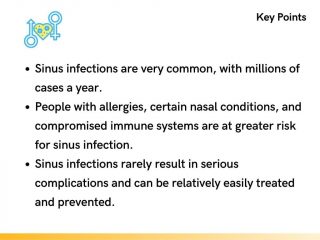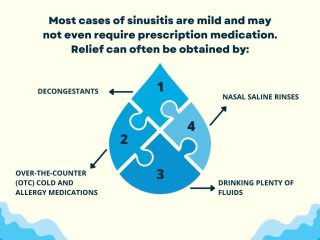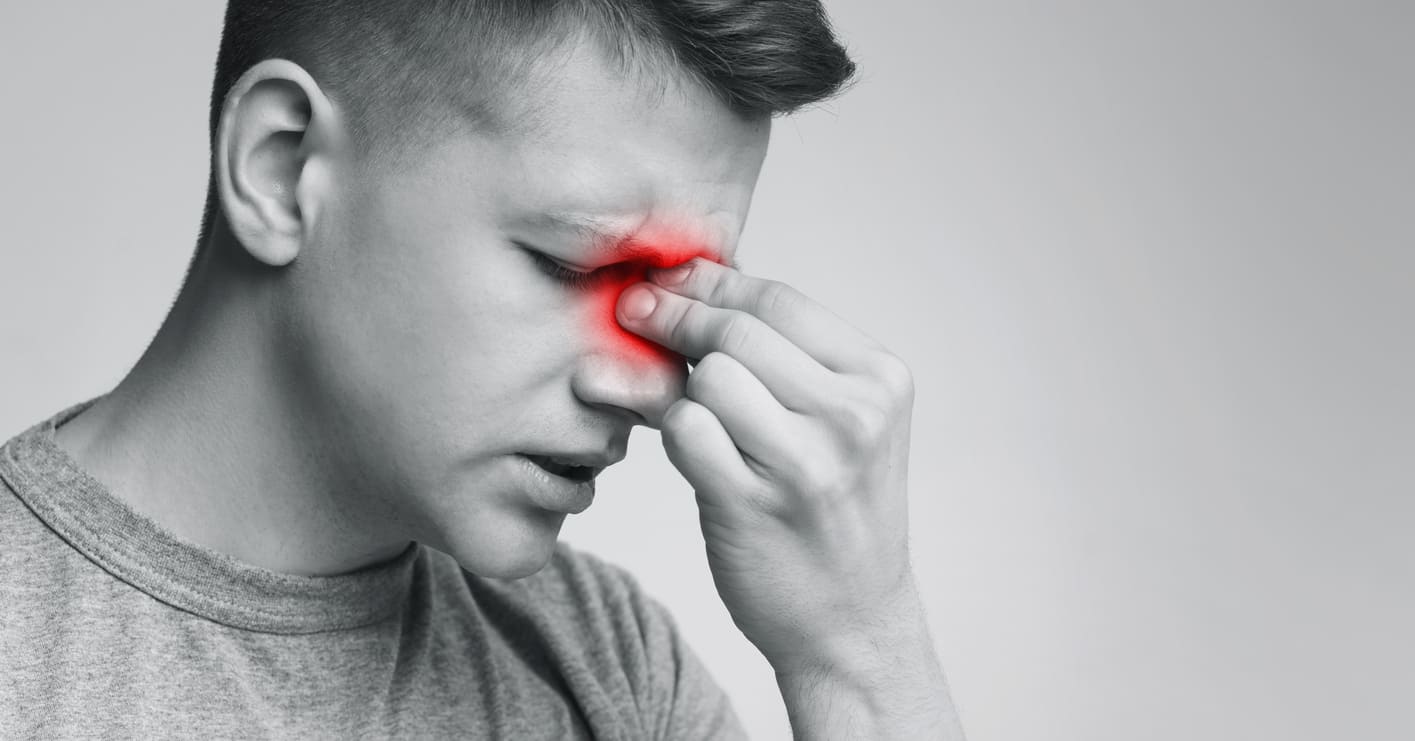Sinus infection or sinusitis is a major health problem. It afflicts 31 million people in the United States annually.

A sinus infection, a medical condition known as “sinusitis,” is inflammation of the sinuses. The sinuses are air-filled cavities located around the nose, cheeks, and forehead. The sinuses are your body’s “drainage system,” designed to be one of your immune system’s first lines of defense by draining out mucus and, along with it, germs and pathogens that enter through the nose.
A sinus infection is the reason for millions of trips to the doctor every year. Most people experience a sinus infection from time to time, but people with allergies, nose blockages like a deviated septum, and compromised immune systems are more prone to sinus infection.
Sinus infections can be caused by bacteria or viruses. Sinus infections are treated fairly easily, and there are measures you can take to try to avoid them. They are rarely serious unless left untreated.
What Is a Sinus Infection?
A sinus infection occurs when the sinus passages become inflamed due to infection by either a virus or bacteria. The sinuses are cavities behind your face that are filled with air. When to are inflamed due to a viral or bacterial infection, they cannot drain and become filled with fluid. This causes pain, a stuffy nose, and the other symptoms typical of sinusitis.
Sinus Infection Signs
Common symptoms of sinus infection include:
- Postnasal drip.
- Discolored nasal discharge, usually whitish-green in color.
- Nasal stuffiness or congestion.
- Tenderness of the face – particularly under the eyes or at the bridge of the nose.
- Headache, pressure, and pain.
- Toothaches
- Ear pressure, feeling of clogged ears, ear pain.
- Bad breath.
- Coughing.
- Fever.
- Fatigue.
Differentiating Sinus Infection from Other Ailments
A sinus infection is often confused with the common cold or, more recently, a case of COVID-19 or even allergies like hay fever. However, colds, flu, COVID, and other related ailments usually only impact the nasal passages, causing a stuffy nose, or “rhinitis,” and not clogged sinuses and the pressure and pain typical of sinus infection.
However, that is not to say that you cannot have a sinus infection along with these other conditions. It is not uncommon for a cold, for example, which is caused by a virus, to lead to a viral sinus infection. So, how do you tell the difference between a cold and a sinus infection? Cold symptoms typically only last for about three to five days and then improve in about a week. A sinus infection, without diagnosis and treatment, tends to stick around a lot longer longer. If you have a runny nose, stuffy nose, and sinus pressure that lasts for more than 10 days, it is most likely a sinus infection and not just a cold or allergies.

What Causes Sinus Infections?
Sinus infections are caused by bacteria or viruses that get swept into the sinus passages through the nose and are not drained out with the normal process of discharging mucus. The regular function of the sinuses is to be part of your body’s “air filtration and drainage system.” Your sinuses are lined with mucus membranes that trap dust, germs, and other pathogens in the air. Tiny hair-like projections in the sinuses, known as cilia, sweep the mucus – and whatever it has trapped — down into the throat and into the stomach, where the pathogens are destroyed. This is a normal and ongoing process that is part of your body’s natural defense against sickness and disease.
The “sweepers” can’t do their job when bacterial or viral infections or allergies cause nasal tissues to swell. The swelling traps mucus in the sinuses, resulting in the pressure, pain, and other symptoms typical of sinusitis.
Bacterial and Viral Origins
Various pathogens, including fungi, bacteria, and viruses, cause sinus infection, but most have viral or bacterial origins – and of those two, viruses, like the virus that causes the common cold, are the most common cause of sinusitis. Bacteria also can cause sinusitis. If you have a runny, stuffy nose, sinus pressure, along with facial pain that persists for a week or more, there’s a good chance that you have bacterial sinusitis. Antibiotics and decongestants usually work well on bacterial sinusitis. If your symptoms seem to improve but then return and are worse than the initial symptoms after using antibiotics, then it is more likely viral sinusitis. But only a proper exam and culture taken by your doctor can determine the definitive origin of your sinus infection.
Allergies and Environmental Factors
Allergens and other environmental factors certainly contribute to sinus infection, particularly chronic sinus infection. Sinusitis is considered to be chronic if it persists for 10 weeks or more. Allergies cause the nasal and sinus passages to become swollen and inflamed in an attempt to flush out the offending matter that triggered the allergic reaction. This can be dust, mold, or pollen.
Risk Factors for Developing Sinus Infections
In addition to allergies, chronic respiratory conditions like asthma have been closely linked to an increased risk of developing sinus infections, as have any conditions that lead to a compromised immune system. Physical abnormalities of the nose that cause obstructions also increase your risk of chronic sinus infection.

Treatment Options for Sinus Infections
The good news is that except in some very rare circumstances where they can spread to the brain, sinus infections are rarely serious and readily treated. Treatment options will be based on the diagnosis of the type of sinus infection you have.
Medical Approaches
Medical interventions for sinus infections include the following:
Antibiotics – Antibiotics are the usual treatment for bacterial sinus infections. Antibiotics are usually taken from 3 to 28 days, depending on the type of antibiotic.
Nasal decongestant sprays – Prescription nasal decongestants can be quite useful in relieving the swelling and other symptoms of sinus infection but should not be used for more than a few days at a time.
Antihistamines – Antihistamines are the standard prescription for allergic reactions, so they can help fight symptoms of allergies that can lead to swollen nasal and sinus passages.
Nasal corticosteroid spray – These prescription nasal sprays address the major problem of sinus infection by reducing or eliminating swollen nasal and sinus passages.
Home Remedies and Self-Care

When Surgery Is Necessary
If you have recurrent or chronic sinusitis and it has not responded to any of the treatments mentioned above, surgery may be recommended as a last resort. It is usually performed by an otolaryngologist. Anatomical defects like a deviated septum or nasal polyps are the most common targets of sinus surgery.
Prevention and Lifestyle Choices
There are some preventative measures you can take that may help lower your risk of sinus infections, including:
- Using a “neti pot” or other device to cleanse your nose regularly.
- If you are aware of your allergies, take steps to manage them by avoiding your triggers and seeing your allergist for shots and other treatments as needed.
- Use steroid nasal sprays if your doctor recommends them.
- Stay up to date on recommended vaccines such as for flu and COVID-19.
- Use a clean humidifier to moisten the air at home.
- Establishing good handwashing and other habits that are known to reduce your risk of contracting infectious diseases.
- Avoiding smoking and exposure to secondhand smoke.

